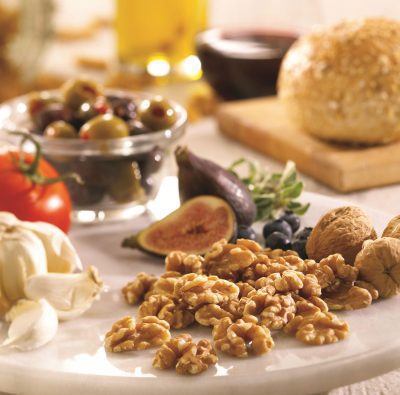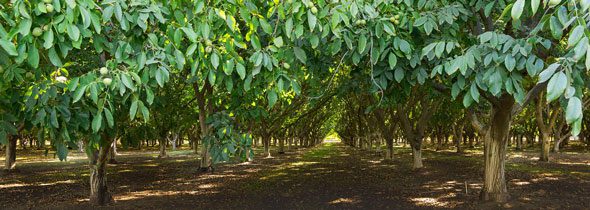 From Our Orchard to Your Table
From Our Orchard to Your Table
It’s a long road from planting a walnut orchard to delivering fresh, delicious walnuts to domestic and international markets. Find out about the process from tree to table, and the strict food quality and safety standards that regulate the walnut industry.
Each step in the process from propagation, to harvest, to packer, and finally to market is handled with care and attention. There are over 4,500+ walnut growers, a large majority being family farms, many of which have been in the walnut business for several generations.
Walnut production takes commitment and patience, and orchards are dedicated to only walnut production. After a walnut sapling is planted, it takes five to seven years for it to grow into an adult tree suitable for harvesting walnuts.
Harvesting
Harvesting begins in late August, when the drying green hulls start to split (allowing the inshell walnuts to be removed), and continues until late November. First, the orchard floor is swept clean. Then, mechanical shakers vigorously shake each tree and thousands of walnuts fall to the ground. The walnuts are carefully swept into windrows to allow mechanical harvesters to pick them up for cleaning.
Processing
The outer green hull is removed by a huller and the nut is mechanically dehydrated (air-dried) to the optimum 8% moisture level. This prevents deterioration of the nut and protects its quality during storage. Walnuts are stored until ready for shipment.
Walnut Packing
When orders are placed, walnuts are transported to a packing plant where they are prepared to be shipped in one of two formats – inshell and shelled.
Inshell Walnuts
Following drying, sizing of the inshell nut occurs. Inshell walnuts are sized as jumbo, large, medium, or baby according to USDA standards. They are then packaged and shipped for consumers around the world to enjoy cracking open to experience the delicious nut inside.
Shelled Walnuts
Walnuts for both consumer and industrial use are removed from storage as needed and sent to the shelling department where they are mechanically cracked. The shelled material is screened to remove the broken shells from the flavourful nut itself which are called kernels. The kernels are screened into a series of sizes, air-separated from any remaining shells, and pass through electronic colour graders and shell sorters. Finally, they are hand-sorted by trained sorters and certified by for quality and USDA standards; then, they are ready for packing.
Once shelled, walnut kernels are visually inspected to ensure an end product that is clean, well-dried, and of a specified colour, as determined in comparison to the official walnut colour chart.
Tolerances for total and special defects are specified for each grade. Laboratory tests, both chemical and microbiological, are conducted to meet strict regulatory agency and food safety requirements.
 California Walnuts Meet Strict Quality Control Standards
California Walnuts Meet Strict Quality Control Standards
California Walnuts are produced under stringent quality controls that exceed California inspection standards, reputed to be the world’s toughest standards. Handlers also meet individual customers’ standards and specifications. Many cutting-edge technologies are harnessed during the process in a sustained effort to deliver walnuts of uncompromising quality.
The walnuts are grown and processed under the strict regulation of the California Walnut Board, USDA/DFA and the US Food and Drug Administration (FDA). A food safety control program and quality control regime (HAACP) is in place that meets the standards imposed by all regulatory authorities.
Packaging
California Walnuts are produced in a wide variety of sizes, colour grades and combinations of sizes and colours to meet the specifications of any industrial formulation. Commercial product meets the same high standards of quality as those sold directly to the consumer.
Check out our walnut storage tips. See the page Buy, Care, & store


 California Walnuts Meet Strict Quality Control Standards
California Walnuts Meet Strict Quality Control Standards